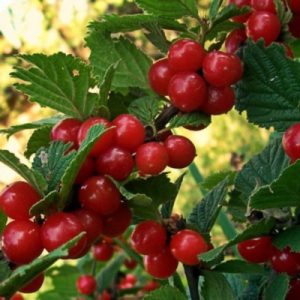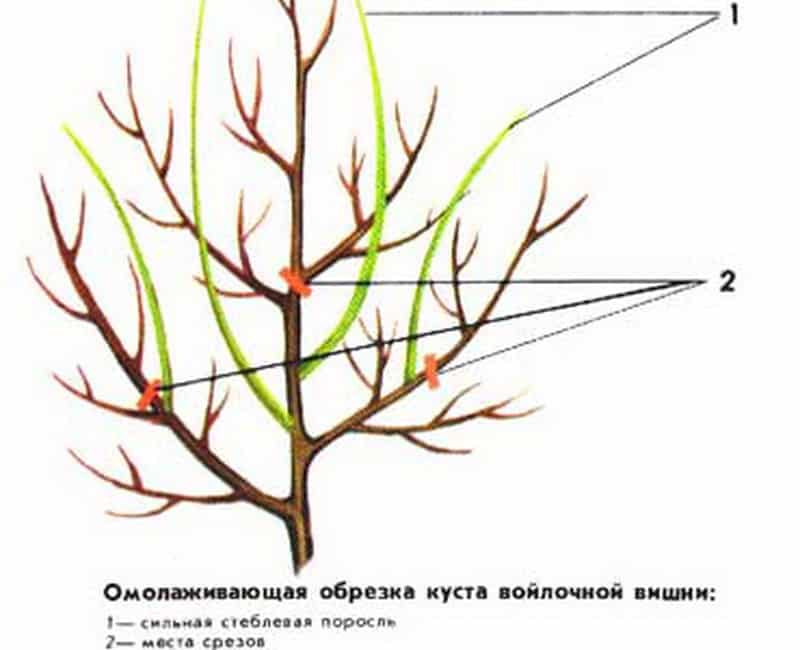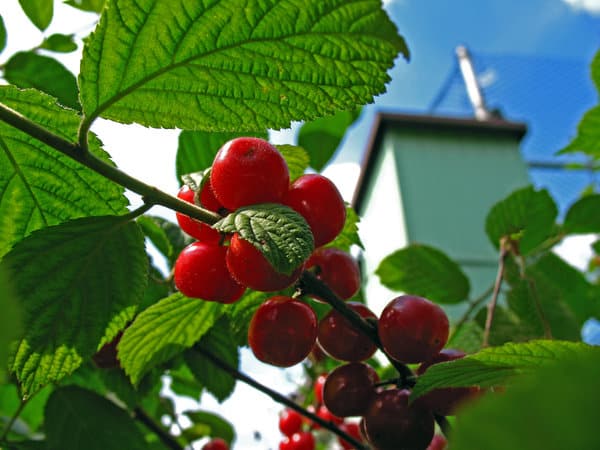A step-by-step guide to pruning felt cherry trees in summer for beginners.
Gardeners love felt cherries for their good harvest, ease of care and beautiful compact crown. To increase fruiting, the plant is pruned not only in autumn and spring, but also in summer. If you know the cutting techniques and patterns, the work will not be difficult.
Is it possible to prune felt cherry trees in summer?
If the weather is consistently warm, humidity levels are high, and too much nitrogen was added during fertilizing, felt cherry many young shoots are formed. They will take nutrition from the berries, will not have time to grow and will die in the winter. In this case, summer pruning is carried out.
Pruning goals
Main goals of the procedure:
- formation of the correct crown shape;
- plant rejuvenation;
- preventing uneven development;
- ensuring good lighting and ventilation of the crown;
- preventing early aging of cherries;
- increasing the quality and quantity of the harvest;
- removal of non-bearing shoots.
Summer pruning is carried out only when absolutely necessary, for example, when branches are broken or young shoots have begun to grow too much.
When to prune cherry trees in summer
The procedure is carried out in early June, when the cherries have just begun to fill. If you do not make it on time, it is better to postpone the haircut to July, after harvesting. This will protect the tree after frost occurs.
Favorable days
Pruning is always carried out only on a sunny and dry day: this way the risk of introducing fungal diseases will be minimal.
Immediately after removing excess branches, the wounds are treated with garden varnish or emulsion paint. Ordinary clay is suitable as an alternative.
Types of pruning
Felt cherry grows up to 2-3 m in height and resembles a small tree.
Therefore, all types of pruning are applied to it, as for ordinary cherries:
- Formative. Crown formation schemes are universal and applicable to any type of cherry and growing region. The peculiarity of this method is fruiting on bouquet branches. They produce crops for 5 years, but only if their length is more than 30 cm.
- Regulatory. They carry out this every year by removing thickening branches.
- Restorative. Performed after an unsuccessful winter, when many branches were damaged by frost. They are completely removed.
- Rejuvenating. The first time is carried out when the tree is 8-9 years old. The need for the procedure is indicated by a decrease in the length of annual growth to 20 cm and exposure of the ends of the shoots. Anti-aging pruning is not done at once, but over 2-3 years.
How to trim a tree correctly

Haircut ensures that a sufficient amount of sun enters the crown and normal air circulation. It is important to do it correctly so as not to damage the tree.
Required materials and tools
For pruning you will need:
- pruning shears for thin branches;
- lopper for branches with a diameter of up to 2.5 cm, which are located deep in the crown;
- garden saw.
All tools are disinfected in advance to prevent infection from entering the plant. They are calcined over a fire or wiped with a cloth moistened with alcohol.
Additionally, prepare garden varnish or oil paint for processing the cuts.
Trimming schemes
In summer, drying and damaged branches that can harm the tree are removed.
Attention! Particular attention is paid to diseased shoots: they are not simply cut off, but burned to kill the infection.
After fruiting, the young shoots of the felt cherry are partially removed so that new ovaries and buds appear next year. This is done only in regions with a warm climate. In the north of the country they limit themselves to sanitary pruning. The formative one is transferred from summer to spring.
In the summer, shoots that have not yet become woody are pinched. Young branches are removed at a very early stage. If this is not done in time, you will have to remove woody shoots, and this is worse for the tree.
Step-by-step instruction
Pruning felt cherry trees in summer consists of several steps:
- The crown is inspected and thinned out every year. Remove all thickening and damaged branches.
- The buds are located along the entire length of the shoots, so they are cut off completely.
- Branches growing upward are cut by 1/3 to prevent the cherry from growing too tall.
- About a third of the side branches are cut off, and the rest are shortened by 3 buds.
All cut areas are treated with garden varnish or other wound healing agent.
Features of pruning depending on the age of the tree
The cherry crown begins to form in the first year after planting.
To create the shape of an annual plant, do the following:
- Provide balance in the ratio of the root system and the above-ground part. 5 strong skeletal processes are left on the seedling, which are located at a distance of at least 10 cm from each other. Everything else is completely cut off.
- For excessively tall seedlings, the central conductor is cut off. If the height of the tree is more than 1 m, the top is shortened to 80 cm.
- In the first year, thin shoots are removed. Long side branches are pruned by 15 cm. Skeletal branches should not be higher than the central one.
In the next 4 years, pruning consists only of removing thickening shoots. To do this, remove all branches growing inside the crown.
The branched part is fully formed by 5 years. Such plants are given a sanitary trim as they become overgrown.
Depending on the growing region
Depending on the climate and weather conditions in a particular region, the timing varies slightly.
In the southern parts of Russia, pruning is carried out in June, and in the middle zone and northern regions - in July.
Further care of the plant

After pruning, sections of old and young branches are equally vulnerable and require disinfection. To do this, various means are used to isolate damage from the external environment.
Most often used:
- garden var;
- oil paint based on drying oil;
- special paste or putty.
The products prevent bacteria and insects from entering the wound and reduce fluid loss from the tree in the first hours after pruning.
Important! Before covering the wounds, carefully remove all irregularities. The product is applied with a spatula to a dry surface.
Some gardeners use the Novosil biostimulator to increase the plant's defenses after pruning. 3 ml of the drug is diluted in a bucket of water. The solution is watered around the tree trunk.
Advice from experienced gardeners
Basic recommendations from summer residents:
- During frosts, gum appears on the stumps, so the cut is made carefully to reduce the likelihood of stumps.
- The branches are formed in the direction from the center outwards.
- They even prune cherry trees that are not strong enough, but in this case the amount of work is minimal. Basically they just thin out the crown.
- Thickened areas are thinned out greatly, and dry areas are completely removed.To prevent the proliferation of pathogenic microorganisms, all cut branches are removed from the site and burned.
- When the cherry tree grows very quickly, it is limited by pruning the upper branches. This allows you to correctly form the crown.
This is interesting:
Step-by-step instructions: how to grow felt cherries from seeds at home
Instructions for transplanting cherries to another place in the summer for beginner gardeners
Conclusion
Summer pruning of felt cherry is considered an auxiliary procedure, but it should not be neglected. During development, new shoots rapidly form in a young plant; if they are not removed, fruiting will be at risk.
In summer, it is important to remove thickening, dry and diseased shoots. The procedure is usually carried out in July, and the wounds must be treated with a disinfectant.